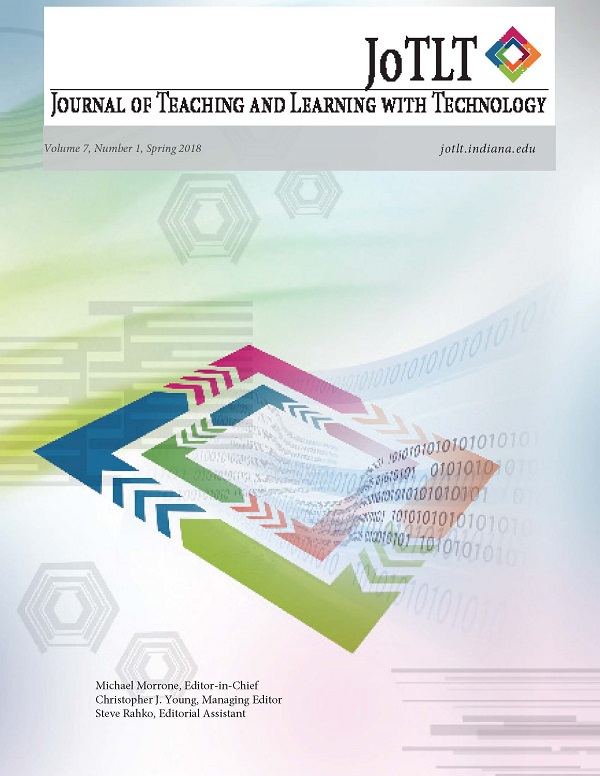Introducing a Pre-Determined Feedback Pool for Evaluating Students’ Online Discussion Participation
Main Article Content
Abstract
As self-regulation for successful online learning is a relatively new focus in online education, more attention is directed toward initiatives to help students become more cognizant of their learning efforts in online learning environments. Grounded in the idea that self-regulation is feedback dependent, we argue for the necessity of instructor feedback on student performance in online classes. The specific focus is instructor feedback on students’ online discussion contributions. To assist instructors in managing their feedback practices in large online classes with numerous discussion entries, we present a feedback pool that includes a range of predetermined comments instructors can choose from while assessing their students’ discussion participation.
Downloads
Article Details
- Authors retain copyright and grant the Journal of Teaching and Learning with Technology (JoTLT) right of first publication with the work simultaneously licensed under a Creative Commons Attribution License, (CC-BY) 4.0 International, allowing others to share the work with proper acknowledgement and citation of the work's authorship and initial publication in JoTLT.
- Authors are able to enter separate, additional contractual agreements for the non-exclusive distribution of the journal's published version of the work (e.g., post it to an institutional repository or publish it in a book), with an acknowledgement of its initial publication in JoTLT.
- In pursuit of manuscripts of the highest quality, multiple opportunities for mentoring, and greater reach and citation of JoTLT publications, JoTLT encourages authors to share their drafts to seek feedback from relevant communities unless the manuscript is already under review or in the publication queue after being accepted. In other words, to be eligible for publication in JoTLT, manuscripts should not be shared publicly (e.g., online), while under review (after being initially submitted, or after being revised and resubmitted for reconsideration), or upon notice of acceptance and before publication. Once published, authors are strongly encouraged to share the published version widely, with an acknowledgement of its initial publication in JoTLT.
References
Agee, J. and Uzuner Smith, S. (2011). Online discussions in a doctoral research methods course: Like a text by many authors. Studies in Continuing Education, 33(3), 301-319.
Artino, A. R. and Stephens, J. M. (2009). Academic motivation and self-regulation: A comparative analysis of undergraduate and graduate students learning online. The Internet & Higher Education, 12, 146-151.
Charmaz, K. (2006). Constructing grounded theory: A practical guide through qualitative analysis. Thousand Oaks, CA: Sage.
Cho, M-H. and Shen, D. (2013). Self-regulation in online learning. Distance Education, 34(3), 290-301.
Garrison, D. R. and Cleveland-Innes, M. (2005). Facilitating cognitive presence in online learning: Interaction is not enough. The American Journal of Distance Education, 19(3), 133-148.
Johnson, D. W. and Johnson, R. T. (1993). Cooperative learning and feedback in technology-based instruction. In J. V. Dempsey and G. C. Sales (Eds.), Interactive instruction and feedback. (pp. 133-158). Englewood, NJ: Educational Technology.
Lear, J. (2010). Instructor presence in online distance classes. In Web-based education: Concepts, methodologies, tools, and applications. (pp. 1422-1427). Hershey, PA: Information Science Reference.
Paraskeva, F., Mysirlaki, S. and Choustoulakis, E. (2009). Designing collaborative learning environments using educational scenarios based on SR. International Journal of Advanced Corporate Learning, 2(1), 42-49.
Paus, E., Werner, C. S. and Jucks, R. (2012). Learning through online peer discourse: Structural equation modeling points to the role of discourse activities in individual understanding. Computers & Education, 58, 1127- 1137.
Perera-Diltz, D. M. and Monaghan, C. H. (2014). A dialogue on strategies for effective online counselor education instruction. In G. R. Walz and J. C. Bleuer, (Eds.), VISTAS Online 2014 (article 54). Alexandria, VA: Counseling Outfitters. Retrieved June 9, 2017, from http://www.counseling.org/knowledge-center/vistas
Ryan, G. W. and Bernard, H. R. (2003). Techniques to identify themes. Field Methods, 15, 85– 109.
Shea, P. and Bijerano, T. (2010). Learning presence: Towards a theory of self-efficacy, selfregulation, and the development of communities of inquiry in online and blended learning environments. Computers & Education, 55, 1721-1731.
Shea, P., Hayes, S., Uzuner, S., Vickers, J., Bijerano, T., Pickett, A. and Jian, S. (2012). Learning presence: Additional research on a new conceptual element within the community of inquiry (CoI) framework. The Internet and Higher Education, 15(2), 89-95.
Shen, P. D., Lee, T-H. and Tsai, C-W. (2007). Applying Web-enabled problem-based learning and self-regulated learning to enhance computing skills of Taiwan’s vocational students: A quasiexperimental study of a short-term module. Electronic Journal of e-Learning 5(2), 147–56.
Smith, V. and Palenque, S. M. (2015, February 2). Ten tips for more efficient and effective grading. Faculty Focus. Retrieved June 9, 2017, from https://www.facultyfocus.com/articles/educational-assessment/ten-tips-efficient-effectivgrading/
Sun, J. C-Y. and Rueda, R. (2012). Situational interest, computer self-efficacy and self-regulation: Their impact on student engagement in distance education. British Journal of Educational Technology, 43(2), 191-204.
Vonderwell, S. (2003). An examination of asynchronous communication experiences and perspectives of students in an online course: A case study. The Internet and Higher Education 6, 77-90.
Wandler, J. and Imbriale, W. (2017). Promoting undergraduate student self-regulation in online learning environments. Online Learning, 21(2).
Wu, D. and Hiltz, S. R. (2004). Predicting learning from asynchronous online discussions. Journal of Asynchronous Learning Networks, 8(2), 139-152.
Zhu, E. (2006). Interaction and cognitive engagement: An analysis of four asynchronous online discussions. Instructional Science, 34, 451-480.
Zimmerman, B. J. (2008). Investigating self-regulation and motivation: Historical background, methodological developments, and future prospects. American Educational Research Journal, 45(1), 166-183.
Zimmerman, B. J. and Clearly, T. J. (2009). Motives to self-regulate learning: A social account. In K. R. Wentzel and A. Wigfield (Eds.), Handbook of motivation at school (pp. 247-264). New York, NY: Routledge.
